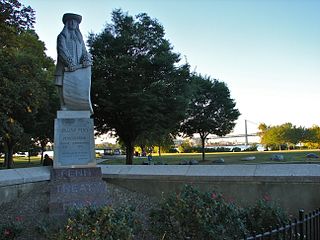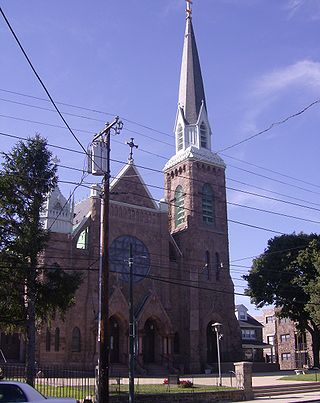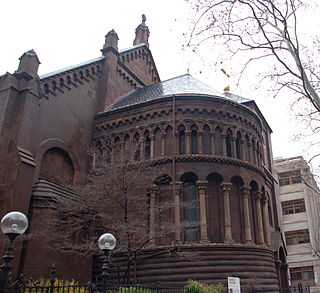
Fishtown is a neighborhood in the River Wards section of Philadelphia, Pennsylvania, United States. Located northeast of Center City Philadelphia, its borders are somewhat disputed today due to many factors, but are roughly defined by the triangle created by the Delaware River, Front Street, and York Street. Some newer residents expand the area to Lehigh Avenue to the northeast, while some older residents shrink the area to Norris Street. It is served by the Market–Frankford Line rapid transit subway/elevated line of the SEPTA system. Fishtown has long been a largely working class Irish Catholic and Irish American neighborhood, though in recent years it has seen a large influx of young urban professionals and gentrification.

Wistanstow is a village and parish in Shropshire, England. Wistanstow is located about 5 miles (8.0 km) south of Church Stretton and 8+1⁄2 miles (13.7 km) north of Ludlow. It is about 2 miles (3.2 km) north of Craven Arms. It is just off the main Shrewsbury-Hereford road, the A49. The large parish, of 5,231 acres, includes a number of other small settlements: Woolston, Upper Affcot, Cwm Head, Bushmoor, Strefford, Whittingslow, Felhampton and Cheney Longville, and a population of 724 was recorded in the 2001 census, increasing to 812 at the 2011 Census.

St. Stephen's Episcopal Church is a historic parish of the Episcopal Diocese of Pennsylvania, founded in 1823 in Philadelphia, Pennsylvania and located at 19 South Tenth Street, on the corner of Tenth Street and Ludlow Street. St. Stephen's was designed by William Strickland in the Gothic revival style. It is the oldest extant building in Philadelphia in this style and was designed by an architect-engineer best known for Greek Revival buildings, though, like his mentor Benjamin Latrobe, he produced buildings in other "picturesque" styles as well. St. Stephen's first service was held on February 27, 1823. On June 4, 1979, it was added to the National Register of Historic Places. On May 28, 1957, it was designated a historic landmark by the Philadelphia Historical Commission.

Holmesburg began as a Village within Lower Dublin Township, Pennsylvania. It is now a neighborhood in the Northeast section of Philadelphia, Pennsylvania, United States. Holmesburg was named in Honor of Surveyor General of Pennsylvania Thomas Holme, who was a cartographer.

St Giles' Parish Church is the parish church of Wrexham, Wales. The church is recognised as one of the finest examples of ecclesiastical architecture in Wales and is a Grade I listed building, described by Sir Simon Jenkins as 'the glory of the Marches' and by W. D. Caröe as a “glorious masterpiece.”

Hiram Clarence Eddy was a United States organist and composer

Rhosddu is a suburb and community in Wrexham County Borough, Wales, covering the north-western parts of the city of Wrexham and comprises the wards of Grosvenor, Garden Village and Stansty.

Saint Clement's Church is an historic Anglo-Catholic parish in Logan Square, Center City, Philadelphia. It is part of the Episcopal Diocese of Pennsylvania. The church, designed by architect John Notman, was built in 1856. It originally incorporated a spire more than 200 feet (61 m) tall; this was found to be too heavy for the foundation and was removed in 1869. In 1929, the church building, which includes the parish house and rectory, and weighs 5,000 short tons (4,500 t), was lifted onto steel rollers and moved 40 feet (12 m) west to allow for the widening of 20th Street. On November 20, 1970, Saint Clement's Church was listed on the National Register of Historic Places.
Frank Rushmore Watson (1859–1940) was a Philadelphia architect specializing in church architecture. He graduated from Central High School, Philadelphia, in 1877. Watson entered the office of Edwin Forrest Durang, an eminent architect concentrating on Roman Catholic church projects during the last quarter of the nineteenth century. Watson spent five years with Durang before establishing his own independent firm in 1882 or 1883. While not limiting his practice to Roman Catholic projects, Watson still became well known for his church designs. So successful was he that he opened a branch office in Atlantic City, New Jersey in 1898. In 1901 or 1902, when Samuel Huckel returned to Philadelphia, a partnership between the two was established under the name Watson & Huckel. Huckel's experience with Benjamin D. Price, another architect known for his church designs, as well as his experience with Edward Hazelhurst in the firm of Hazelhurst & Huckel stood the new partnership in good stead; and the office prospered until Huckel's death in 1917. Watson then continued practicing independently until 1922, when he was joined by the younger architects, George E. Edkins, and William Heyl Thompson. At the outset, this firm was one of association, but soon the name became Watson, Edkins & Thompson. When Edkins moved to Oaklyn, New Jersey in 1936, Watson & Thompson continued in practice until Watson's death in 1940.
The Clifton Heights Orange and Black was a professional football team from Clifton Heights, Pennsylvania, a town located just to the southwest of Philadelphia, from 1921 until around 1932. The team was operated by the Clifton Heights Athletic Association to compete against the other towns of Delaware County. The team was managed by James E. Gallagher and coached by Rusty Yarnell, who also played with the team for a number of years. The Orange and Black consistently fielded strong teams that drew the attention of competitive clubs from neighboring Philadelphia, New Jersey and Delaware. The Orange & Black even played the Frankford Yellow Jackets and Pottsville Maroons of the early National Football League.

Grace Church, Mt. Airy is an historic Episcopal church, which is located at 224 East Gowen Avenue in the Mount Airy neighborhood of Philadelphia, Pennsylvania.

Our Lady of Warraq is believed, by some, to be a mass apparition of the Virgin Mary that occurred at the Coptic Orthodox Virgin Mary and Archangel Michael church, in Warraq al-Hadar, Giza, Egypt, in the early hours of Friday 11 December 2009.

Nicola D'Ascenzo was an Italian-born American stained glass designer, painter and instructor. He is best known for creating stained glass windows for the Washington Memorial Chapel in Valley Forge, Pennsylvania; the Nipper Building in Camden, New Jersey; the Loyola Alumni Chapel of Our Lady at Loyola University Maryland; the Folger Shakespeare Library and Washington National Cathedral, both in Washington, D.C.

The University of South-Eastern Norway, commonly known as USN, is a Norwegian state university. It has campuses in Bø in Telemark, Porsgrunn, Notodden, Rauland, Drammen, Hønefoss, Kongsberg and Horten. USN is a continuation of the three former university colleges, Telemark University College, Buskerud University College and Vestfold University College, which merged between 2014 and 2016 to form the University College of South-Eastern Norway. The institution was granted the status of a full university by the King-in-Council on 4 May 2018.
The Church of the Good Shepherd, Kensington, was an Episcopal congregation in Kensington neighborhood of Philadelphia, Pennsylvania. Founded in 1868, it merged with Emmanuel Church, Kensington, in 1994 to form the Church of Emmanuel and the Good Shepherd. Its 1887 building, designed by architect T. Frank Miller and located at 2121-2127 East Cumberland Street, was demolished in 2016. The Church of the Good Shepherd, Kensington, was an among the few surviving reminders of the mid to late 19th century English immigrant experience and community in Kensington and Philadelphia. Movement has been made to celebrate the colonial experience and preserve the 19th century "new immigrant" experience in the greater Kensington area. Scholars often refer to this immigrant group as hidden and forgotten. These immigrants, to outsiders, blended in and disappeared. However, as the property demonstrates, mid to late 19th century English immigrants, far from being hidden, built unique neighborhoods, cultural institutions, and worship sites.
The Church of the Messiah, Richmond, was an Episcopal congregation in the Port Richmond neighborhood of Philadelphia, Pennsylvania. Founded in 1846, it merged with St. Matthew's Mission, Oxford Circle, 1929 to form Church of the Messiah, Oxford Circle. Its 1848 Gothic Revival building, designed by architect John Notman and located at 2640-2658 East Huntington Street, was demolished in 2016.
St. Luke's Church, Kensington, was an Episcopal congregation in Kensington neighborhood of Philadelphia, Pennsylvania. The parish was founded in 1904 as an outgrowth of the Episcopal Hospital Mission. The church – located at the northwest corner of East Huntingdon and B Streets at Kensington Avenue – was designed by Allen Evans of Furness & Evans, and completed in 1904. Its parish house, just north of the church, was designed by Furness & Evans, and completed in 1905. Description: "The new [parish house] building will cost $35,000, and is to be a two-story building constructed of Holmesburg granite. The first floor will be used for classes—the Sunday School numbers 1,500,—the second floor for the chapel and library, and a gymnasium will be located in the basement."
Holy Spirit Church, Nandakhal is a historic Roman Catholic Church in Vasai (Bassein), Maharashtra, India. This church was built in 1573 by Portuguese Missionaries.












